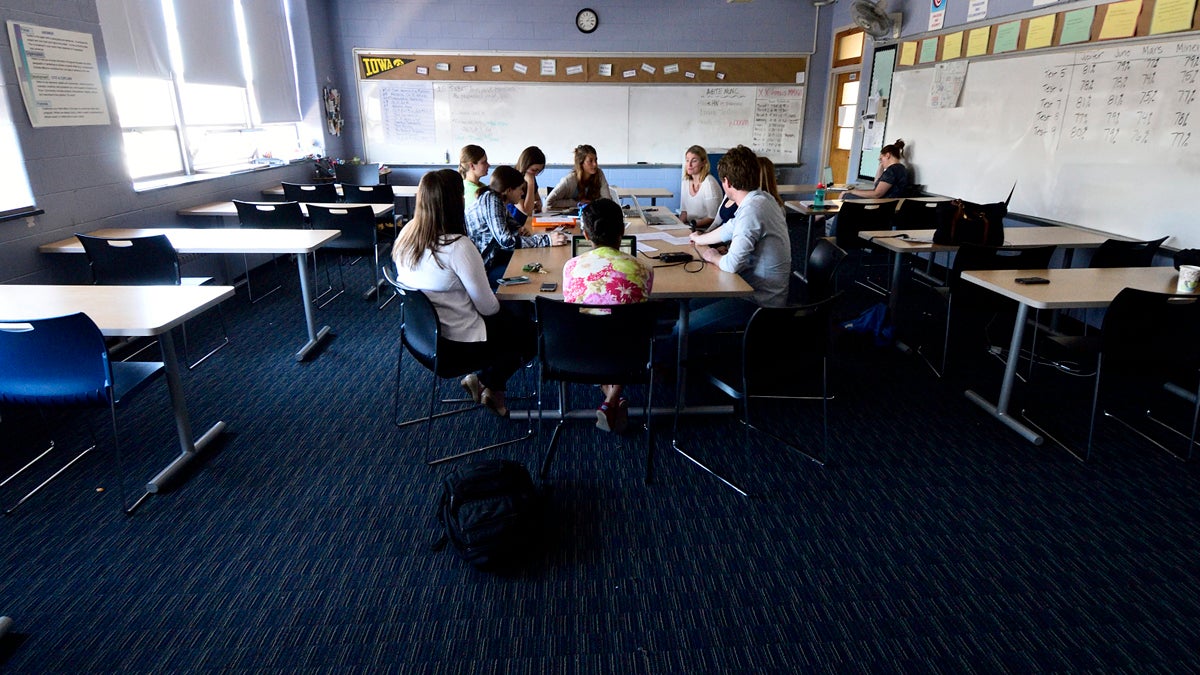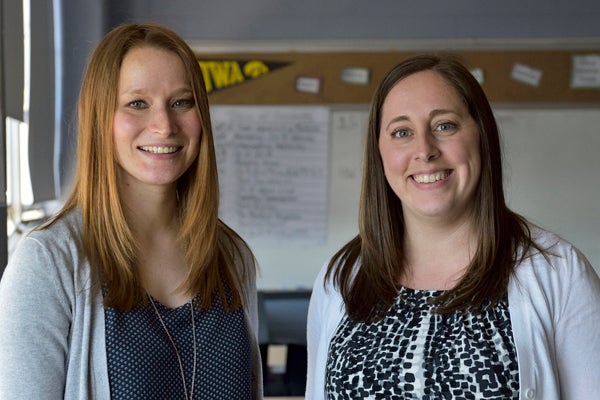In Philadelphia, school counselors take on at-home trauma in the classroom
Listen
Cristo Rey faculty get one full day a week to collaborate and strategize about how to meet the specific needs of individual students. (Bas Slabbers/for WHYY)
School counselor Pam Turner-Bunyon had been warned: This new, incoming student had a dark profile and was prone to very erratic behavior.
“When he first came to us, he ran out of the building, the first day — the very first day — instead of coming in, he ran,” she said.
Turner-Bunyon learned what happened and immediately took off, dashing out into the crime-prone streets that surround the school.
“I found out he was running so I went and chased him down, and coaxed him back in and we worked to develop safety places in the building,” she said.
Turner-Bunyon has 15 years under her belt as counselor at Feltonville Intermediate, a Philadelphia public school serving grades three, four and five. Most students come from low-income families.
Years ago, in the same situation, she would have reacted differently — maybe gotten angry and tried to lecture the student sternly about his misbehavior.
But that was before she learned about “trauma-informed” education care.
“It’s saying, ‘What can we do to intentionally work with children … and minimize the stress so that children are able to think and function in school,'” she said. “And not saying, ‘Oh, you’re just an angry kid, you need to do X, Y and Z.'”
For Turner-Bunyon, that means first recognizing the often profound weights that many students carry with them through their lives, and helping to ease them with individualized attention.
“And so for him, it was trying to figure out a safe spot that he could go to that he could feel alone, and that he could escape,” she said. “And one of the things that we found out really quickly, he and I did, is that he really likes to read.”
But what works for one child doesn’t work for another. She has many students who live in the depths of poverty; others with family members who have recently suffered sudden, violent deaths; and still others who have come across the bodies of close relations who have committed suicide.
Like the student who sought refuge in running, many of these students struggle to focus in the classroom, and their stressors can manifest in often unruly ways.
“A kid will be throwing a desk and throwing a chair, and I will have to go up and get them,” she said. “It’s real crisis stuff.”
But over time, Turner-Bunyon has become adept at quickly de-escalating these situations — often by engaging students’ senses.
“I have students who come in who, for example, need hugs in the morning. So, I give them hugs,” she said. “And you can see that, totally, just that hug changes their ability to be able to function.”
For others, the answer can be plastic — as in the stock of empty water bottles she keeps in her office.
“We play games to make them as small as you possibly can,” she said. “And the sound and the physically breaking them apart help to calm kids down.”

Pam Turner-Bunyon has 15 years under her belt as counselor at Feltonville Intermediate, a Philadelphia public school serving grades three, four and five. Most students come from low-income families. (Kevin McCorry/WHYY)
ACES high
Turner-Bunyon became interested in the connection between violence trauma and education through training provided by the school district — training that’s guided by the work of one of the top researchers in the field, Drexel University associate professor Sandra Bloom.
“The same areas of the brain that we need for performing academically are the parts of the brain often that are most negatively impacted by toxic stress,” said Bloom.
Bloom has been at the forefront of scholarship that delves into the effects of what are known as “adverse childhood experiences” that can literally change the way the brain is wired.
“Now, because of research that’s been done, we understand that exposure to all different kinds of adversity in childhood can produce lots of health, mental health and social problems in adulthood,” Bloom explained. “That may seem kind of obvious, but we haven’t — until quite recently — had the science to back it up.”
The adverse childhood experiences, or ACES, study began in San Diego in 1998. It found a staggering correlation between the extent of experiences of abuse and neglect in childhood and rates of early death, substance abuse and other crippling ailments later on.
“And that’s been pretty revolutionary, because it says that what happens to you when you’re little, then determines 50 years later, your health,” she said.
Overcoming the effects of trauma — which are often amplified and exacerbated by poverty — is no small feat, but Bloom said schools should be primed to take on this responsibility.
“We have an opportunity in schools to help children compensate for whatever problems exist in the family,” she said. “But to do that, we have to understand that education needs to be more than reading, writing, and arithmetic — that we really need to help kids develop socially and emotionally as well if we want them to have good academic performance.”
But that will take rethinking the way we see misbehavior in school.
Children who live in the relentlessly stressful conditions of poverty, and who experience the toxic stress of abuse or neglect, can become chronically trapped in a state of fight or flight — a physiological phenomenon that blocks higher cognitive ability and can give children a hair-trigger response system.
So even seemingly little things can sometimes blow up into disruptive incidents.
But when teachers and counselors take the time to de-escalate students’ stress the way Turner-Bunyan describes, over time, it can be a major boon to overall health.
“Those can then become basically therapeutic experiences for those kids,” Bloom said.
Realistic?
To truly implement that kind of approach would will take a gigantic commitment to the importance of the issue and the resources to back it up. That’s a very challenging prospect for a perpetually cash-strapped public school district such as Philadelphia.
At Feltonville Intermediate, school counselor Turner-Bunyon knows those challenges all too well.
“Oh, that’s a definite big thing,” she said, “because I’m the only counselor here for 700-plus students.”
She’s been trying to implement these theories in the midst of dealing with an array of other fires and limited support.
“There’s no road map here. We’re kind of creating our own as we go along,” she said.
The availability of the training that the district offers is limited, and often fills up quickly. Turner-Bunyon has actually become one of the district’s official instructors, but because many of the teachers in her school haven’t been able to get in, she also does training on the fly to whomever will listen.
“It’s now my passion, and, so as soon as I get the information, I’m trying to give it out to people,” she said. “I think it’s the thing that can transform the way we view education.”
It’s hard for Turner-Bunyon to even fathom a school where the trauma-informed model is taken to its ideal, but it may exist just two miles away in Philadelphia’s Olney neighborhood.
At Cristo Rey Philadelphia High School, a private school for low-income students that opened four years ago, the staff built a program from the ground up with a holistic trauma-informed model in mind.
“We’re fortunate that because we started it this way, that we’ve really set that precedence that this is where we’re going to focus,” said school psychologist Rachel Hodas.
Compared with the district’s schools, Cristo Rey is stacked with support staff. It has three full-time counselors and three other counseling interns for 450 students. A whole other department focuses on higher-education placement.
Cristo Rey faculty also get one full day a week to collaborate and strategize about how to meet the specific needs of individual students. At a mock-exercise that the school recently opened up for NewsWorks, the staff developed a hypothetical case file in order to illustrate how they approach student issues.
About a dozen teachers gathered around a table to discuss issues and possible solutions for a student whose interest in academics had begun to lag.
“In February or March, she just started coming in later,” said teacher Eva Porter. “So she would miss days, and then she would miss assignments, and miss notes, and from then on her grades started to drop.”
After getting input from all of the student’s teachers, head of counseling Laura Schmidt provided the staff some context based on a one-on-one session with the child.

School psychologist Rachel Hodas and head of counseling Laura Schmidt of Cristo Rey Philadelphia High School. (Bas Slabbers/for WHYY)
“She did say that you can share that something’s going on at home that’s affecting her at school,” said Schmidt, “and she wants to pick up her grades.”
After spending 25 minutes discussing the student, the team developed a strategy to implement over the coming days and weeks, and moved on to another case file.
‘National wealth on a bonfire’
To take this sort of approach across Philadelphia’s public schools would require a major new investment in counseling staff and teacher training.
But as costly as that would be, Drexel’s Sandra Bloom believes it would be well worth it.
“Right now, we might as well just put our national wealth on a bonfire, and just set it alight because we’re wasting all this money later on health care and mental health care and social services and suffering that doesn’t have an economic price figure attached,” she said, “that really we wouldn’t have to if we just take care of kids.”
Until that happens, Bloom said many students — especially those at under-resourced schools such as Feltonville — are being set up for failure.
WHYY is your source for fact-based, in-depth journalism and information. As a nonprofit organization, we rely on financial support from readers like you. Please give today.




